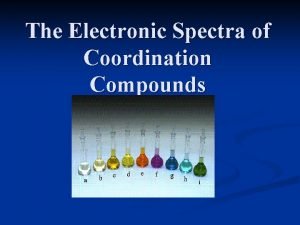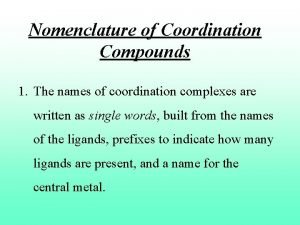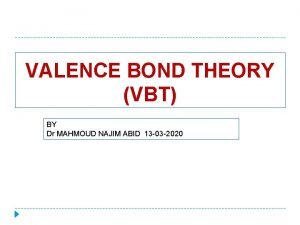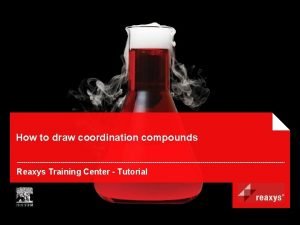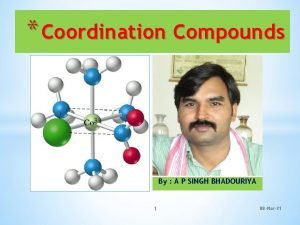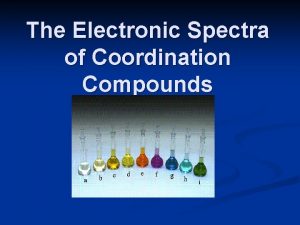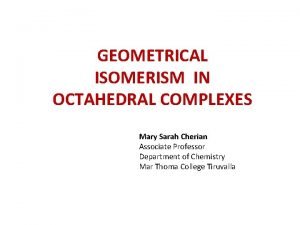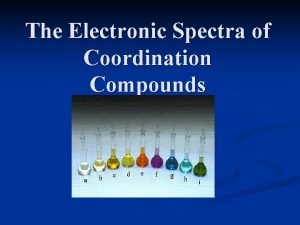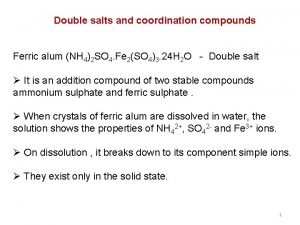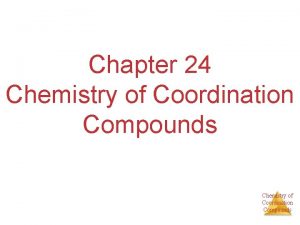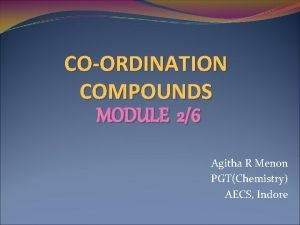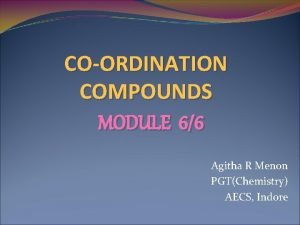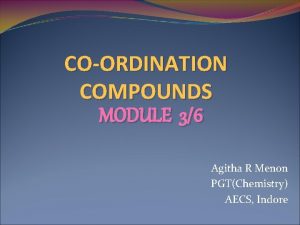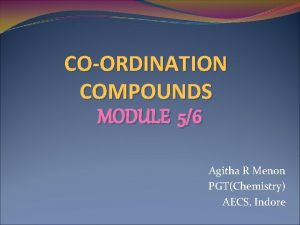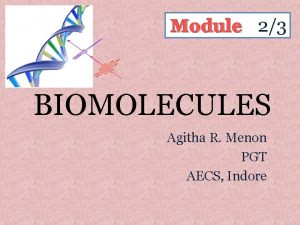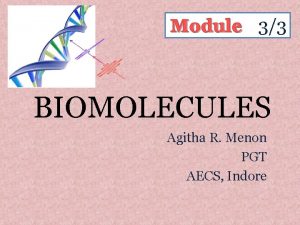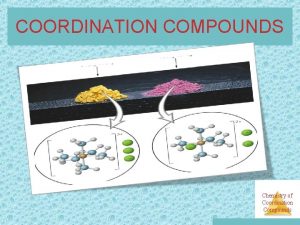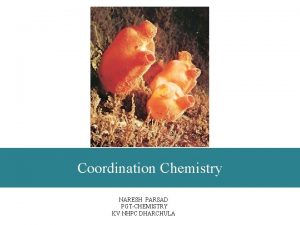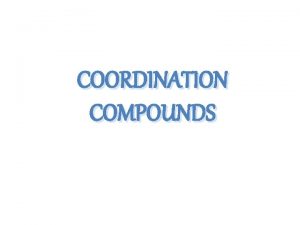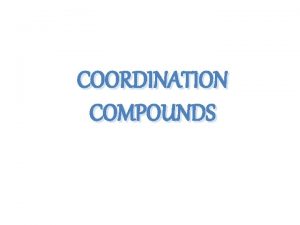COORDINATION COMPOUNDS MODULE 16 Agitha R Menon PGTChemistry













- Slides: 13

CO-ORDINATION COMPOUNDS MODULE 1/6 Agitha R Menon PGT(Chemistry) AECS, Indore

Coordination Compounds Coordination compounds are chemical compounds that consist of nonmetal atoms or groups of atoms, called ligands, that are bound to a central metal atom via chemical bonds. Coordination compounds are also referred to as coordination complexes. e. g. , Potassium ferrocyanide, K 4[Fe(CN)6] Nickel carbonyl , [Ni(CO)4]

Werner’s Theory of Coordination Compounds Alfred Werner became the first Swiss chemist to win the Nobel Prize in 1913 for his work on the linkage of atoms and the coordination theory In complexes, metal ions show two types of valencies primary valency Non directional, is the number of charges on the complex ion, ionisable. secondary valency – Directional, equals to the number of ligands coordinated to the metal, non ionisable. In a series of compounds of cobalt(III) chloride with ammonia, it was found that some of the chloride ions could be precipitated as Ag. Cl on adding excess of Ag. NO 3 solution in cold but some remained in solution.

The compounds are formulated as shown in Table below

Difference between a double salt and a complex DOUBLE SALTS: double salt exist only in solid state and dissociate into ions in aqueous solution or any other solvent. they loose their identity in aqueous solution or any other solvent. the properties of the double salt is same as their constituents. Example: carnallite, KCl. Mg. Cl 2. 6 H 2 O, Mohr’s salt, Fe. SO 4. (NH 4)2 SO 4. 6 H 2 O, potash alum, K 2(SO 4). Al 2(SO 4)3. 24 H 2 O, etc COMPLEX COMPOUND: complex compounds exhibit in solid state as well as in water or any other solvent complex compounds do not completely loose their identity in aqueous solution. the properties of the complex compounds are different from their constituents

Complex ion or Coordination Entity It is an electrically charged species in which central metal atom or ion is surrounded by number of ions or neutral molecules. (i) Cationic complex entity: It is the complex ion which carries positive charge. e. g. , [Pt(NH 3)4]2+ (ii) Anionic complex entity: It is the complex ion which carries negative charge. e. g. , [Fe(CN)6]4 -

Central Atom or Ion The atom or ion to which a fixed number of ions or groups are bound is known as central atom or ion. It is also referred as Lewis acid. e. g. , in [Ni(H 2 O)4 CI 2], Here Ni 2+ is the central metal ion. It is generally a transition element or an inner-transition element. {Exceptions: Mg is the central atom in the cordination compound of chlorophyll}

Ligands are electron donating species (ions or molecules) bound to the Central atom in the coordination entity. These may be charged or neutral. Ligands are of the following types : (i) Unidentate It is a ligand, which has one donor site, i. e. , the ligand bound to a metal ion through a single donor site. e. g. , H 2 O, NH 3, etc. (ii) Didentate It is the ligand which have two donor sites. E. g. , H 2 NCH 2 NH 2 (ethane-1, 2 -diamine) or C 2 O 4 2– (oxalate), (iii) Polydentate It is the ligand, which have several donor sites. e. g. , [EDTA] 4 is hexadentate ligand. (iv) Ambidentate ligands These are the monodentate ligands which can ligate through two different sites, e. g. , NO 2 -, SCN-, etc. (v) Chelating ligands Di or polydentate ligands cause cyclisation around the metal atom which are known as chelate ligand , Such ligands uses two or more donor atoms to bind a single metal ion and are known as chelating ligands. More the number of chelate rings, more is the stability of complex. The stabilisation of coordination compounds due to chelation is known as chelate effect.

Coordination Number It is defined as the number of coordinate bonds formed by central metal atom, with the ligands e. g. , in [Pt. CI 6]2 - Pt has coordination number 6. In case of monodentate ligands, Coordination number = number of ligands In polydentate ligands, Coordination number = number of ligands * denticity

Coordination Sphere The central ion and the ligands attached to it are enclosed in square bracket which is known as coordination sphere. The ionisable group written outside the bracket is known as counter ions. Coordination Polyhedron The spatial arrangement of the ligands which are directly attached to the central atom or ion, is called coordination polyhedron around the central atom or ion.

Oxidation Number of Central Atom The charge of the complex if all the ligands are removed along with the electron pairs that are shared with the central atom, is called oxidation number of central atom. e. g. , [Cu(CN)4]3 -, oxidation number of copper is +1, and represented as Cu(I). [Cr(H 2 O)4 Cl 2]+

Types of Complexes 1. Homoleptic complexes Complexes in which the metal atom or ion is linked to only one kind of donor atoms, are called homoleptic complexes e. g. , [Co(NH 3)6]3+ 2. Heteroleptic complexes Complexes in which the metal atom or ion is linked to more than one kind of donor atoms are called heteroleptic complexes e. g. , [Co(NH 3)4 CI 2]+

References: 1. NCERT Class XII Chemistry Vol 1 2. Google images
 Coordination position isomerism
Coordination position isomerism Correlation diagram in coordination chemistry
Correlation diagram in coordination chemistry Nomenclature of coordination compounds
Nomenclature of coordination compounds Important postulates of valence bond theory
Important postulates of valence bond theory Drawing coordination compounds
Drawing coordination compounds Werners theory of coordination compounds
Werners theory of coordination compounds Electronic spectra of coordination compounds
Electronic spectra of coordination compounds Geometrical isomerism in coordination compounds
Geometrical isomerism in coordination compounds Coordination sphere example
Coordination sphere example Electronic spectra of coordination compounds
Electronic spectra of coordination compounds Ferric alum as a double salt
Ferric alum as a double salt Polydentate ligand
Polydentate ligand Venu menon md
Venu menon md Dr asha menon
Dr asha menon

